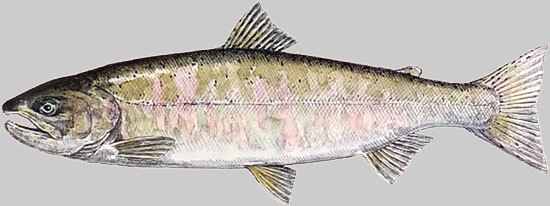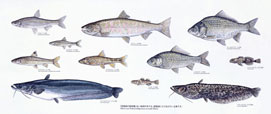Biwamas is a indigenous species that inhabits Lake Biwa and the surrounding rivers.
Since young fish has parr marks and vermilion dots on the body side, it is hard to distinguish from Amago.
After they go down to Lake Biwa, parr marks and vermilion dots disappear after a while, and the color of body turns into silver gray.
The feature of Biwamasu has Slender body, round nose and large eyes compared with Sakuramasu (Cherry salmon) or Satsukimasu (Red spotted masu salmon).
The fry that hatched in the river eats aquatic insects etc., grows, and gets down to a lake during the rainy season of the next year.
They inhabits the northern part of Lake Biwa of deep low temperature mostly, and eat Biwa goby, Sweet fish, Amphipoda etc.,
and grow to about 60cm from 30cm in two to four years, and go up to the rivers flowing into the northern part of the lake mainly in late November from mid-October to spawn, and finish their lives.
It was thought that they all go down to the lake in the year that hatched, and go up to the rivers just before the spawn,
but it has also become clear there are early ascent type or landlocked type.
|
 |
Biwamas are the important aquatic resources that support the fishery of Lake Biwa,
and artificial incubation is also performed,
but the population is decreasing by aggravation of the native habitat by river improvement etc. every year.
It was specified as the Red List of Ministry of the Environment as a near threatened species (NT) now.
They were transplanted to Lake Chuzenji in Tochigi Prefecture, Lake Kizaki in Nagano Prefecture, Lake Ashinoko in Kanagawa Prefecture, etc.
Around 1975 when I began fishing, it was able to fish with lure etc. at the lakefront near the mouth of rivers in the spawning season,
but now capture of the Biwamasu was forbidden from October 1 to November 30 for resource conservation.
Lake trolling has been done in recent years as a recreational fishing,
but since the number of recreational fishing persons increased,
it became the Approval System that restricts the number of recreational fishing persons from the former notification system for resource protection and trouble prevention with fisherpersons in 2013.
 |


